

26/07/2024
Abstract
Due to survey data on benthic species composition in Cua Lo coastal area is limited, the article provides data on species composition, differences and distribution levels of benthic animals in coastal and island areas as well as contributing to completing research on benthic diversity and proposing management and conservation of biodiversity in the coastal area of Cua Lo (Nghe An) in particular and Vietnam in general. The research applies sampling methods in Cua Lo coastal area (Nghe An): Field research methods (collection methods, animal fixation and storage methods) and laboratory research methods (determination of nomenclature of types and data processing methods). Results of analysis of research samples have identified 86 species belonging to 3 main groups (Bivalvia, Crustacea and Grastropoda). Crustaceans have the highest number of species with 33 species, followed by gastropods with 29 species and bivalve molluscs with the lowest number of species with 24 species. 5 species with only identified genera should be kept as sp. (Grapsus sp.; Neoliomera sp.; Alia sp.; Olivella sp. and Gibbula sp.).
Keywords: Nghe An, Zoobenthos, Gastropoda, Crustacea, Bivalvia.
JEL Classifications: P48, Q56, Q57.
Received: 19/2/2024; Revised: 11/3/2024; Accepted: 25/5/2024
1. Introduction
Cua Lo sea area (Nghe An) has relatively flat terrain and a long coastline creating tourist beaches that are one of the beautiful beaches of Vietnam. Besides, there are many islands and peninsulas that create wonderful landscapes, create outstanding economic development, and at the same time serve as a premise for important research on biodiversity and ecology to find ecotourism solutions and environmental protection. Cua Lo beach area is surrounded to the north by Lan Chau island and Lam River to the south. On the other hand, in Cua Lo waters, Lan Chau Island is located close to the coast; 4km from the shore is Hon Ngu Island. These two islands have different ecosystems in both area and habitat, so there are differences in the distribution of coastal benthic animals. Lan Chau island is located right next to the coast (also known as Ru Coc), the island's foot sinks below sea level at high tide, the west of the island connects to the mainland into a peninsula at low tide, to the east are steep cliffs stretching towards the sea. Hon Ngu Island consists of 2 islands, large and small, with an area of only 2.5 km², has a more diverse ecosystem and is home to many benthic species.
Benthic animals in the sea have certain economic significance; many groups have been identified as having an important daily food role for coastal residents and export value such as shrimp, crabs, fiddler crabs, snails. The coastal area of Cua Lo is exploited by humans without planning and without management measures, leading to benthic resources at risk of ecological imbalance. With the important role of benthos, there have been studies related to benthic species in the surrounding area such as: (H.N. Khac, 2021) Assessing the crab species composition in the mangrove ecosystem (Thanh Hoa), (N.T. Binh, 2022) Research on species composition and distribution of benthic animals in Vung Ang waters (Ha Tinh). Currently, in the coastal area of Cua Lo (Nghe An), there is no research data on benthic groups in this area.
Survey data on benthic species composition in Cua Lo coastal area is still limited. Therefore, this article provides data on species composition, differences and distribution levels of benthic animals in coastal and off-island areas. At the same time, it contributes to completing research on benthic diversity and proposes management and conservation of biodiversity in the coastal area of Cua Lo (Nghe An) in particular and Vietnam in general.
2. Methods and Materials
Time: Qualitative and quantitative samples were collected in June - July 2023 in the coastal area of Cua Lo (Nghe An). Sampling points are identified, numbered and recorded (Figure 1).
Research subjects: Subjects are all species belonging to 3 groups of benthic animals (Crustacea, Gastropoda and Bivalvia).
Field research methods:
- Sampling method: Samples were collected from the bottom, tidal flats, substrates, including spaces above trees and deep in the bottom until all benthic animals were gone. For tidal areas, use a triangular rake with a 1mm mesh size (25 x 25cm) and drag the rake across the bottom to collect benthic animals. Samples were collected from all groups of crustaceans, gastropods and bivalve molluscs until no longer found. The location of sampling points is determined by coordinates.
- Sample fixation and preservation: After washing, the sample was fixed in 70o alcohol. Samples are distinguished from each other by numbered labels, clearly stating the location and location of sampling, then brought back to the laboratory for analysis.
Laboratory research methods:
- Determine species nomenclature: In the process of classifying 3 groups of benthic animals (Crustaceans, Gastropoda and Bivalvia) based on the morphological characteristics of the outer shell according to descriptive documents such as:
+ Crab group (Brachyura): According to the legal identification of crab species (Dai and Yang, 1994), (Crane, 1975);
+ Bivalvia and Gastropoda): Determined according to species nomenclature (Kent and Volker, 1998); (Han and Jap, 2006);
- Data processing methods: Data in the study were processed using Microsoft Excel 2010 software. Maps were processed and drawn using Map Info software 15.0.
All samples after analysis are separated by species, counted and stored at the laboratory of the Vietnam Environmental and Marine Science Institute.
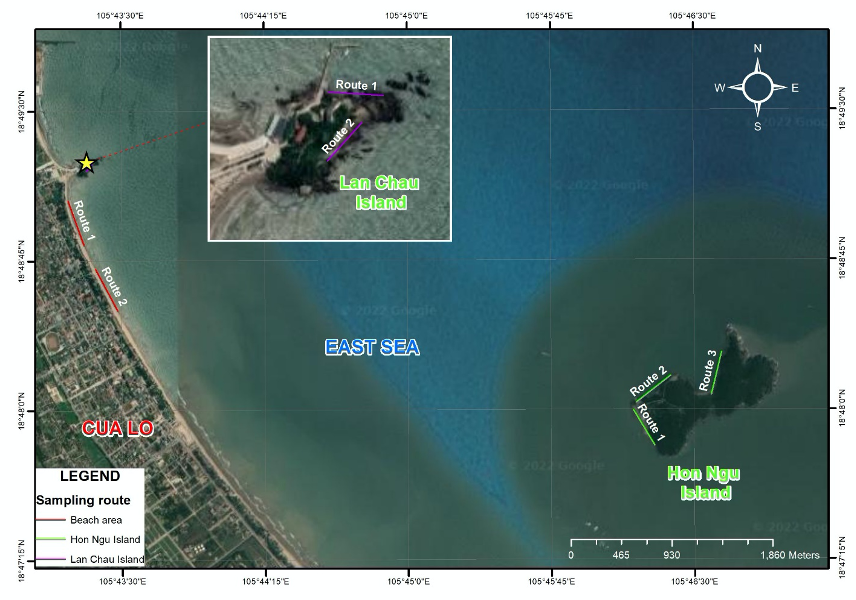
Figure 1. Sampling routes in the coastal area of Cua Lo (Nghe An)
3. Results and discussions
3.1. Benthic fauna composition
Research results on benthic species composition collected in the coastal area of Cua Lo, Nghe An province have identified 86 species, belonging to 66 genera, 45 families and 18 orders belonging to 3 main groups (Bivalvia, Crustacea and Grastropoda). Among them, the Veneridae family is the most diverse with 7 species (accounting for 8.14% of the total number of species), the two families Arcidae and Portunidae have 6 species (accounting for 6.98% of the total number of species). The remaining families have a small number of species, less than 5 species. The species has not been identified, only the genus of 5 species has been identified (Grapsus sp.; Neoliomera sp.; Alia sp.; Olivella sp. and Gibbula sp.), Table 1.
Table 1: Composition of benthic fauna in Cua Lo coastal area
|
TT |
Taxon |
Allocation |
||
|---|---|---|---|---|
|
Coastwise |
Lan Chau Island |
Hon Ngu Island |
||
|
Arthropoda |
||||
|
Crustacea |
||||
|
Penaeidae |
||||
|
1 |
Metapenaeus ensis (De Haan, 1844) |
X |
||
|
2 |
Mierspenaeopsis hardwickii (Miers, 1878) |
X |
||
|
3 |
Parapenaeopsis sculptilis (Heller, 1862) |
X |
||
|
4 |
Penaeus indicus (H.Milne - Edwards, 1837) |
X |
||
|
5 |
Penaeus monodon (Fabricius, 1798) |
X |
||
|
Sergestidae |
||||
|
6 |
Acetes japonicus Kishinouye, 1905 |
X |
||
|
Porcellanidae |
||||
|
7 |
Petrolisthes armatus (Gibbes, 1850) |
x |
||
|
Diogenidae |
||||
|
8 |
Diogenes mixtus Lanchester, 1902 |
x |
||
|
9 |
Diogenes violaceus Henderson, 1893 |
x |
x |
|
|
Alpheidae |
||||
|
10 |
Alpheus dispar Randall, 1840 |
x |
||
|
Palaemonidae |
||||
|
11 |
Nematopalaemon tenuipes (Henderson, 1893) |
x |
||
|
12 |
Macrobrachium equidens (Dana, 1852) |
x |
||
|
13 |
Paradorippe granulata (De Haan, 1841 |
|||
|
14 |
Eucrate crenata (De Haan, 1835) |
x |
||
|
Grapsidae |
||||
|
15 |
Grapsus tenuicrustatus (Herbst, 1783) |
x |
x |
|
|
16 |
Grapsus sp. |
x |
||
|
Leucosiidae |
||||
|
17 |
Leucosia anatum (Herbst,1783) |
x |
||
|
18 |
Lyphira heterograna Ortmann, 1892 |
x |
||
|
Matutidae |
||||
|
19 |
Ashtoret lunaris (Forskål, 1775) |
x |
||
|
Portunidae |
||||
|
20 |
Charybdis anisodon (De Haan, 1850) |
x |
||
|
21 |
Charybdis callianassa (Herbst, 1789) |
x |
||
|
22 |
Charybdis feriatus (Linnaeus, 1758) |
x |
||
|
23 |
Portunus sanguinolentus (Herbst, 1783) |
x |
||
|
24 |
Portunus pelagicus (Linnaeus, 1766) |
x |
||
|
25 |
Portunus trituberculatus Rathbun, 1902 |
x |
||
|
Sesarmidae |
||||
|
26 |
Parasesarma bidens (De Haan, 1835) |
x |
x |
|
|
27 |
Parasesarma leptosoma (Hilgendorf, 1869) |
x |
x |
|
|
28 |
Parasesarma plicatum (Latreille, 1803) |
x |
||
|
Xanthidae |
||||
|
29 |
Neoliomera sp. |
x |
||
|
Squillidae |
||||
|
30 |
Miyakella nepa (Latreille in Latreille, Le Peletier, Serville & Guérin, 1828) |
x |
||
|
31 |
Oratosquilla oratoria (de Haan, 1844) |
x |
||
|
32 |
Amphibalanus amphitrite Darwin, 1854 |
x |
x |
x |
|
33 |
Tetraclita rubescens Nilsson-Cantell, 1931 |
x |
x |
|
|
BIVALVIA |
||||
|
Arcidae |
||||
|
34 |
Anadara cornea (Reeve, 1844) |
x |
||
|
35 |
Anadara inaequivalvis (Bruguiere, 1789) |
x |
||
|
36 |
Anadara subcrenata (Lienschke, 1869) |
x |
||
|
37 |
Barbatia domingensis (Lamarck, 1819) |
x |
||
|
38 |
Barbatia foliata (Forsskål, 1775) |
x |
||
|
39 |
Lunarca ovalis (Bruguière, 1789) |
x |
||
|
Cardiidae |
||||
|
40 |
Vepricardium burnupi (G. B. Sowerby III, 1897) |
x |
||
|
Psammobiidae |
||||
|
41 |
Asaphis violascens (Forsskål, 1775) |
x |
||
|
Mytilidae |
||||
|
42 |
Perna vidiris Linnaeus. 1758 |
x |
||
|
Isognomonidae |
||||
|
43 |
Isognomon ephippium (Linnaeus, 1758) |
x |
||
|
Ostreidae |
||||
|
44 |
Ostraea belcheri G. B. Sowerby II, 1871 |
x |
||
|
45 |
Saccostrea glomerata (Gould, 1850) |
x |
x |
|
|
46 |
x |
x |
||
|
Pinnidae |
||||
|
47 |
Atrina vexillum (Born, 1778) |
x |
||
|
Anomiidae |
||||
|
48 |
Anomia chinensis Philippi, 1849 |
x |
||
|
Mactridae |
||||
|
49 |
Mactra violacea Gmelin, 1791 |
x |
||
|
Veneridae |
||||
|
50 |
Circe scripta (Linnaeus, 1758) |
x |
||
|
51 |
Clausinella brongniartii (Payraudeau, 1826) |
x |
||
|
52 |
Globivenus toreuma (Gould, 1850) |
x |
||
|
53 |
Meretrix lyrata (Sowerby, 1851) |
x |
||
|
54 |
Meretrix lusoria (Röding, 1798) |
x |
||
|
55 |
Paphia textile (Gmelin, 1791) |
x |
||
|
56 |
Tivela planulata Broderip & Sowerby, 1829 |
x |
||
|
Tellinidae |
||||
|
57 |
Bosemprella incarnata (Linnaeus, 1758) |
x |
||
|
GASTROPODA |
||||
|
58 |
Pomacea canaliculata (Lamarck, 1822) |
x |
x |
x |
|
Planaxidae |
||||
|
59 |
Planaxis sulcatus (Born, 1778) |
x |
x |
|
|
Turridae |
||||
|
60 |
Gemmula gemmulina (Martens, 1902) |
x |
||
|
Turritellidae |
||||
|
61 |
Turritella bacillum Kiener, 1843 |
x |
||
|
62 |
x |
|||
|
Neritidae |
||||
|
63 |
Nerita albicilla Linnaeus, 1758 |
x |
x |
x |
|
Calyptraeidae |
||||
|
64 |
Calyptraea chinensis (Linnaeus, 1758) |
x |
||
|
Littorinidae |
||||
|
65 |
Echinolittorina reticulata (Anton, 1838) |
x |
x |
|
|
66 |
Echinolittorina tuberculata (Menke, 1828) |
x |
x |
|
|
67 |
Littoraria intermedia (Philippi, 1846) |
x |
x |
|
|
Naticidae |
||||
|
68 |
Nerita balteata Reeve, 1855 |
x |
||
|
69 |
Notocochlis tigrina (Roding, 1798) |
x |
||
|
70 |
Polinices didyma (Röding, 1798) |
x |
x |
x |
|
Stenothyridae |
||||
|
71 |
Stenothyra alba Dang et Ho, 2006 |
x |
||
|
72 |
Babylonia areolata (Link, 1807) |
x |
||
|
Buccinidae |
||||
|
73 |
Alia unifasciata (Sowerby, 1832) |
x |
x |
|
|
74 |
Alia sp. |
x |
x |
|
|
75 |
Buccinum undatum Linnaeus, 1758 |
x |
x |
|
|
Columbellidae |
||||
|
76 |
Euplica scripta (Lamarck, 1822) |
x |
x |
|
|
Muricidae |
||||
|
77 |
Murex trapa Röding, 1798 |
x |
x |
|
|
78 |
Thais clavigera (Küster, 1860) |
x |
x |
x |
|
79 |
Thais malayensis Tan & Sigurdsson, 1996 |
x |
x |
|
|
Olividae |
||||
|
80 |
Olivella sp. |
x |
x |
|
|
81 |
Clypeomorus bifasciata (G. B. Sowerby II, 1855) |
x |
x |
|
|
82 |
Clypeomorus pellucida (Hombron & Jacquinot, 1848) |
x |
x |
|
|
Cypraeidae |
||||
|
83 |
Mauritia arabica (Linnaeus, 1758) |
x |
||
|
84 |
Monodonta canalifera Lamarck, 1816 |
x |
x |
|
|
85 |
Gibbula sp. |
x |
x |
|
|
86 |
Umbonium vestiarium (Linnaeus, 1758) |
x |
x |
x |
|
Total |
63 |
23 |
33 |
|
Note: x - Location where the species appears.
Some comments from the research results:
Among the discovered species, crustaceans have the largest number of species (3 orders, 17 families, 23 genera and 33 species, accounting for 38.37%), Next are gastropod molluscs (8 orders, 17 families, 24 genera, 29 species, accounting for 33.72%), bivalve molluscs have the lowest number of species (7 orders, 11 families, 19 genera, 24 species), accounting for 27.79%), Table 1.
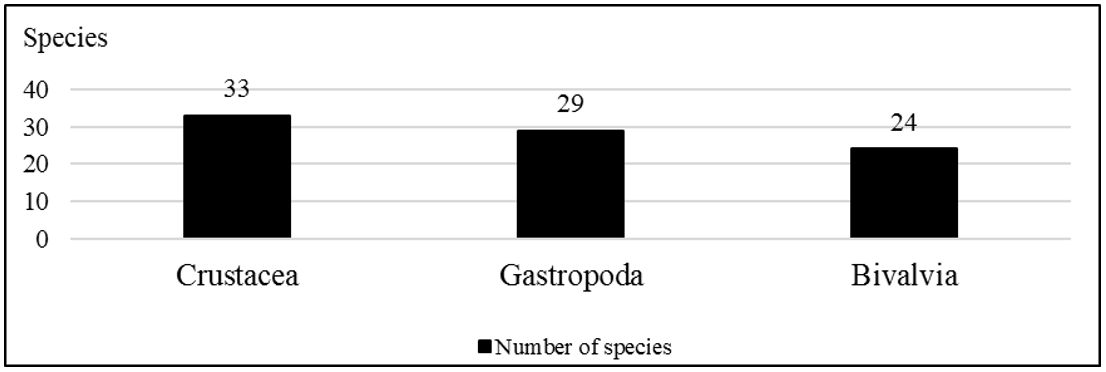
Figure 2: Number of species in the benthic group in Cua Lo waters
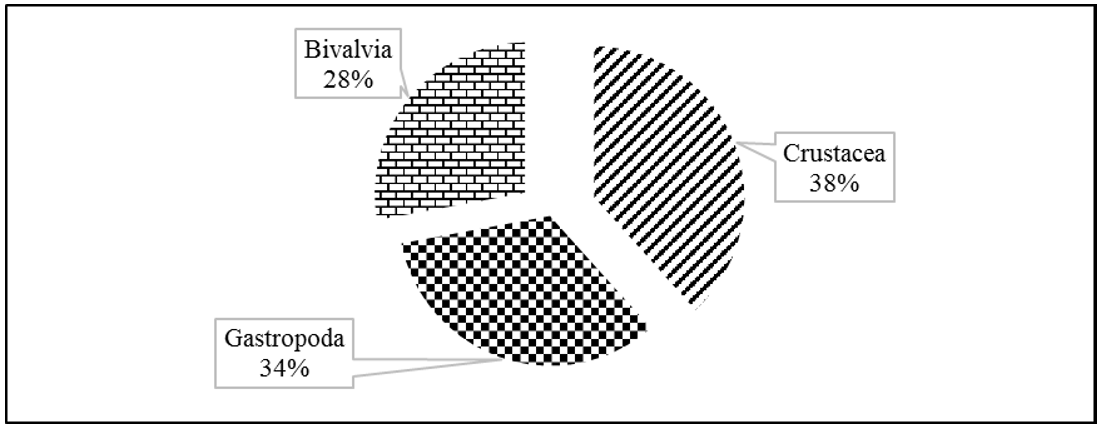
Figure 3: Percentage of species in benthic groups in Cua Lo coastal area
Crustacea: Statistics (Table 1) show that the crustacean group has the most diverse species with 33 species. Among them, the group of crabs (Brachyura) has 17 species (8 species of swimming crabs: Ashtoret lunaris, Charybdis anisodon, Charybdis callianassa, Charybdis feriatus, Portunus sanguinolentus, Portunus pelagicus and Portunus trituberculatus). Next is the shrimp group of 9 species. Other groups only have 1-2 species.

Figure 4: Brachyura species composition in Cua Lo coastal area
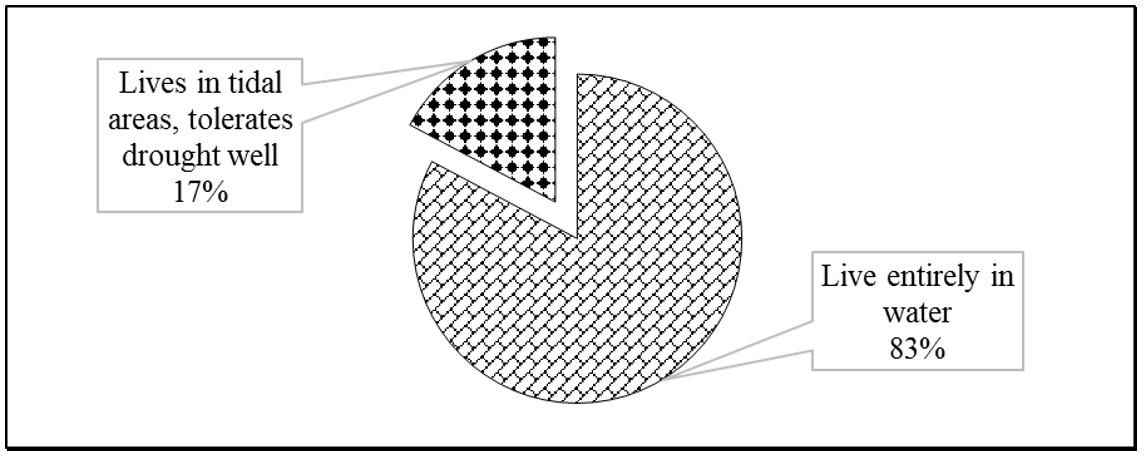
Figure 5: Gastropoda species composition living in seawater and species tolerant to land
Gastropoda: The group of gastropod molluscs according to statistics has 29 species. Among them, there is a group that lives entirely in the seawater environment and a group that has good tolerance in dry land (living in tidal areas, clinging to the coastal bottom), Figure 5.
Gastropods live entirely in aquatic environments, with 24 species identified. For species that live in the intertidal zone and are drought tolerant, 5 species have been identified (Planaxis sulcatus, Echinolittorina reticulata, Echinolittorina tuberculata, Littoraria intermedia and Monodonta canalifera, Table 1 - Figure 5.
Bivalvia: The bivalve mollusc group has identified 24 species. Among them, the group that lives entirely on sand and mud bottoms has 17 species. There are 7 species that live on the substrate (secrete calcium or binder), filter water to get food. (Perna vidiris, Isognomon ephippium, Ostraea belcheri, Saccostrea glomerata, Saccostrea scyphophilla , Atrina vexillum and Anomia chinensis), Table 1 – Figure 5.
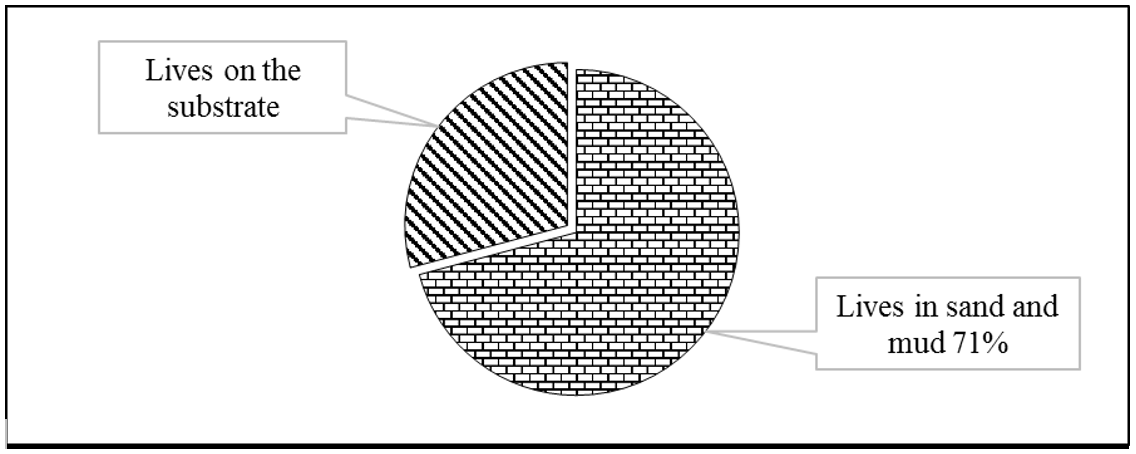
Figure 6: Composition of bivalve species living on sandy, muddy substrates and living on muddy substrates
3.2. Distribution characteristics
Benthic animal species are distributed in the coastal area of Cua Lo according to different habitats. Benthic animals are often distributed in places with suitable habitat and conditions. Therefore, the research team divided into 3 different habitats (Lan Chau Island, Hon Ngu Island and the beach).
Lan Chau Island: Due to human impact, mainly infrastructure is built (tourist wharf, restaurants, hotels, parking lots). Therefore, benthic animals collected in this habitat have the least diverse species composition with 23 species (accounting for 26.74% of the species recorded here), Table 1.
Hon Ngu Island: This is a strictly protected place guarded by the military and accompanying tourist activities at Song Ngu Pagoda. But in coastal areas there is the impact of waves along with cliffs, so benthic animals only include species suitable to live in this environment such as: Ostraea belcheri, Echinolittorina reticulata, Echinolittorina tuberculata, Littoraria intermedia, … Through research, statistics show that there are 33 species (accounting for 38.37% of the species recorded here) distributed on Hon Ngu island, Table 1.
Habitat in the beach area: This is a place where is often affected by humans (beaches, walking places, Ships scrape the seabed, etc.). Therefore, only shell samples and some individuals with intact body conditions were collected for classification. Statistics show that there are 63 species of benthic animals (accounting for 73.26% of species recorded here). Living organisms distributed in this area: Crustacean group (Diogenes mixtus Diogenes violaceus, Acetes japonicus, Paradorippe granulata, Ashtoret lunaris…); Bivalvia (Anadara subcrenata, Saccostrea glomerata, Ostraea belcheri…); Gastropoda (Babylonia areolata, Umbonium vestiarium, Littoraria intermedia…), Table 1.
4. Conclusion
Research results on benthic species composition collected in the coastal area of Cua Lo have identified 86 species belonging to 3 main groups (Bivalvia, Crustacea and Grastropoda). Crustaceans have the highest number of species with 33 species, followed by gastropods with 29 species, and bivalve molluscs have the lowest number of species with 24 species. 5 species whose genus could only be identified should be kept as sp. (Grapsus sp.; Neoliomera sp.; Alia sp.; Olivella sp. and Gibbula sp.).
Regarding distribution: The living environment of Lan Chau Island is due to human impact, mainly built with infrastructure (tourist wharf, restaurants, hotels, parking lots). Therefore, benthic animals collected in this habitat have the least abundant species composition with the least abundant species composition with 23 species; the habitat of Hon Ngu Island has 33 species. Due to the impact of waves following cliffs, benthic animals only include species Ostraea belcheri, Echinolittorina reticulata, Echinolittorina tuberculata, Littoraria intermedia…; the habitat in the beach area has 63 species of benthic animals. Crustacea (Diogenes mixtus Diogenes violaceus, Acetes japonicus, Paradorippe granulata, Ashtoret lunaris…). Bivalvia (Anadara subcrenata, Saccostrea glomerata, Ostraea belcheri…). Gastropoda (Babylonia areolata, Umbonium vestiarium, Littoraria intermedia…).
Currently, in the coastal area of Cua Lo (Nghe An), there is no research data on benthic groups in this area. Therefore, there has been no process of comparing the benthic species composition with previous data. Along with the short benthic research time, the number of species is still limited. Research shows that the Cua Lo benthic ecosystem is experiencing large-scale loss of benthic habitat, receives less attention than other ecosystems, and is under direct threat, due to exploitation, indirectly due to environmental pollution, swimming, garbage and other activities taking place on land. Therefore, there needs to be some solutions to preserve and protect benthic groups such as: Limit exploitation of benthic animals and coastal tidal flats along with educating the community to protect the ecosystem; Limit and prevent the exploitation of species at risk of biodiversity loss; build a strict conservation area for benthic animals at home and offshore; build and develop valuable domestic and international benthic groups.
1Nguyễn Thanh Bình, 1Dư Văn Toán, 2Nguyễn Phương Nhung,
3Dư Thị Việt Nga
1Vietnam Environmental and Marine Science Institute
2University of Transport Technology
3Wuhan University of Geology, China
(Source: The article was published on the Environment Magazine by English No. II/2024)
References
1. Binh N. T., Phuong N.T.B. (2022), The study of zoobenthos composition and distribution Vung Ang - Ha Tinh coastal areas, Science Journal of Tan Trao University. Vol 8, No.3: 18-26.
2. Arthur Anker and Ivan N. Martin (2000), New records and species of Alpheidae (Crustacea: Decapoda) from Vietnam. Part I. Genus Salmoneus Holthuis,1955. Atlantic Volum 54: 295-319.
3. Dai Ai-yun and Yang Si Liang (1991), Crabs of the China seas. China Ocean Press Beijing: 118-558.
4. Han Raven, Jaap Jan Vermeulen (2006), Notes on molluscs from NW Borneo and Singapore. 2. A synopsis of the Ellobiidae (Gastropoda, Pulmonata, Vita Malacologica 4: 29-62.
5. Jocelyn Crane (1975), Fiddler crabs of the World: 15-327.
6. Kent E. Carpenter and Volker H. Niem (1998), The living marine resources of the Western Central Pacific.FAO. Rome. Volum 1: 124-646.
7. Nora F. Y. Tam and Y. S. Wong (2000), Hong Kong mangroves, City University of Hong Kong press: 148p.
8. WoRMS Editorial Board (2022). World Register of Marine Species. Available from https://www.marinespecies.org at VLIZ. Accessed 2022-09-29. doi:10.14284/170.